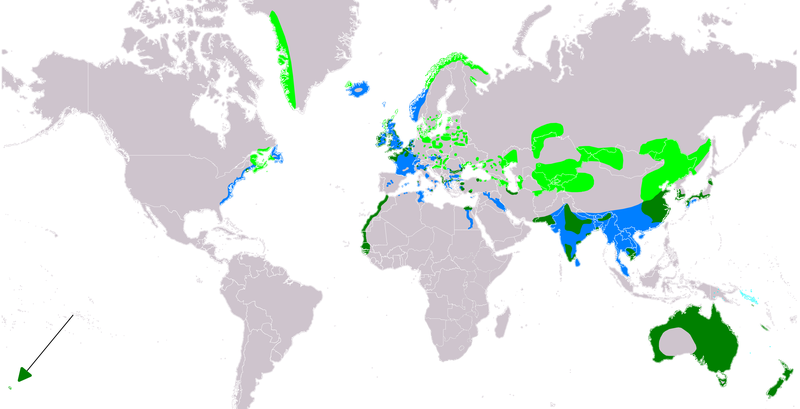CLICK ON PHOTO TO SEE HIGHER QUALITY IMAGE
Click external link here for detailed species information
Click external link here to see distribution map and to hear calls
Wednesday 2 February 2022
GREAT CORMORANT (Phalacrocorax carbo subspecies P. c. carbo) immature at Broadmeadow Estuary, Malahide, Fingal, Co. Dublin, Ireland
Sunday 30 January 2022
GREATER SCAUP (Aythya marila) female at Broadmeadow Estuary, Malahide, Fingal, Co. Dublin, Ireland
Breeding Non breeding - winter
UND77, CC BY-SA 3.0 <https://creativecommons.org/licenses/by-sa/3.0>, via Wikimedia Commons
Wednesday 26 January 2022
RED BREASTED MERGANSER (Mergus serrator) male at Broadmeadow Estuary, Malahide, Fingal, Co. Dublin, Ireland
Sunday 23 January 2022
EURASIAN TEAL (Anas crecca) at Broadmeadow Estuary, Swords, Fingal, Co. Dublin, Ireland
The small scattered resident population in Ireland and Britain greatly increases from September when northern birds begin to arrive. Having overwintered, they begin to disperse back to their breeding grounds and most have gone by the end of March.
The Engineer, CC BY-SA 3.0 <http://creativecommons.org/licenses/by-sa/3.0/>, via Wikimedia Commons
Wednesday 19 January 2022
Sunday 16 January 2022
HOODED CROW or GREY CROW (Corvus cornix) attempting to remove a Common Periwinkle (Littorina littorea) from its shell at Broadmeadow Estuary, Malahide, Fingal, Co. Dublin, Ireland
Click external link here for detailed species information
Click external link here to see distribution map and to hear calls
The Hooded Crow (Corvus cornix) also known as Grey Crow is a member of the crow family Corvidae which is in the genus Corvus.
Four subspecies are generally recognized. Despite the fact that it is
heavily persecuted, it occurs throughout Western Asia including parts of
the Middle East as well as along the Nile Valley in North Africa. It is
also commonly encountered and has a widespread distribution in Northern, Central and Eastern
Europe. It is resident in Ireland, Isle of Man and Northern Scotland. In the rest of Britain as well as Southwestern and Western Europe, it is replaced by the
closely related Carrion Crow (Corvus corone) from which it was split in
2002 and was recognised as a separate species. Where their breeding ranges overlap, they may
hybridise. Some of the northern populations are migratory and move south for the winter.
Saturday 15 January 2022
COMMON GREENSHANK (Tringa nebularia) at Broadmeadow Estuary, Malahide, Fingal, Co. Dublin, Ireland

Tuesday 11 January 2022
BLACK REDSTART (Phoenicurus ochruros) immature at Balscadden Beach, Howth, Fingal, Co. Dublin, Ireland
The Black Redstart (Phoenicurus ochruros) is a small perching bird of the Old World flycatcher family Muscicapidae which is the genus Phoenicurus. It is a locally common resident in central and southern Europe as well as northern Africa. It also occurs in western and central Asia. In the warmer parts of its range it is sedentary. The northern populations migrate in the autumn to spend the winter in southern and western Europe, northern Africa and the Indian sub continent.
Patrick J. O'Keeffe / Raw Birds
Sunday 9 January 2022
COMMON CHIFFCHAFF (Phylloscopus collybita subspecies P. c. collybita) flycatching from the security fencing at the rear of Asgard Apartments, Balscadden Beach, Howth, Fingal, Co. Dublin, Ireland
The Common Chiffchaff (Phylloscopus collybita) is of the family Phylloscopidae which is in the genus Phylloscopus. This small insectivorous species of leaf warbler is a summer resident from mid March to October which breeds in the northern and temperate regions of Eurasia. In the autumn it migrates south to spend the winter in the Mediterranean Basin, sub Saharan Africa and southwestern Asia. Small numbers also overwinter in northwest Europe.
Friday 7 January 2022
BUFF TAILED BUMBLEBEE (Bombus terrestris) one of four workers and a Queen nectering on Hebe Shrub Blossoms (Hebe × franciscana) on 11th January 2022 at Howth Yatch Club, Howth Harbour, Fingal, Co, Dublin, Ireland
Click external link here for detailed species information
Thursday 6 January 2022
YELLOW LEGGED GULL (Larus michahellis) adult and a group of Black Headed Gulls (Chroicocephalus ridibundus) from 07-01-2022 to at least 03-02-2022 at Broadmeadow Estuary, Swords, Fingal, Co. Dublin, Ireland
- Larus michahellis michahellis - breeds in parts of western and southern Europe, as well as the Mediterranean Basin.
- Larus michahellis atlantis - known as Atlantic Gull, breeds on the Atlantic coasts of France, Iberia, Morocco, Canary Islands, Madeira as well as a dark headed form that occurs on the Azores.
Tuesday 4 January 2022
COMMON REDSHANK (Tringa totanus) at Broadmeadow Estuary, Swords, Fingal, Co. Dublin, Ireland

Sunday 2 January 2022
GREAT BLACKED GULL (Larus marinus) 2nd winter, at Faulmore Beach, Faulmore, Mullet Peninsula, Co. Mayo, Ireland

Saturday 1 January 2022
CONTINENTAL CORMORANT (Phalacrocorax carbo subspecies P. c. sinensis) immature on 1st January 2022 at Swords Sailing Club, Broadmeadow Estuary, Malahide, Fingal, Co. Dublin, Ireland
- Broadmeadow Estuary, Swords, 1st winter from 4th to 30th January 2013.
- Broadmeadow Estuary, Swords, 1st winter from 28th January to 16th May 2013, different from above.
- Scotsman Bay, Dunlaoire, adult on 1st February 2014.

































